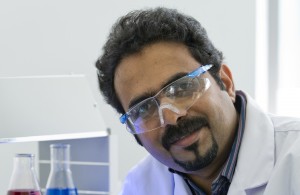The American Chemical Society (ACS), the world’s biggest scientific society, is showcasing pioneering work by an IT Sligo scientist, Professor Suresh Pillai, and international co-researchers on how natural light can be harnessed to protect the environment.
The research team is in the final stages of a three year project which is aimed at devising a process that will utilise more effectively the power of sunlight to destroy environmental pollutants, kill lethal bacteria and protect aquatic life from killer toxins.
The project blends the modern science of nanotechnology with photo-catalysis, the process by which ultraviolet (UV) light generates reactive agents that can degrade threats such as toxins that can kill a wide range of water life, from minnows in Irish lakes to alligators in Florida swamps.
Just 5% of sunlight is UV. The researchers are investigating the extent to which “visible” light, which is non UV, can be utilised to stimulate photo-catalysis and, so, radically strengthen its impact.
The ACS has accepted a scientific article by the team for publication in one of its authoritative journals The Journal of Physical Chemistry Letters. A video about the team’s research is also being featured on the Society’s website.
The team comprises scientists in the USA, Northern Ireland and the Republic of Ireland. The article, which was selected as an “Editor’s Choice”, and video are available online*.
Professor Pillai is known internationally for research into how nanotechnology can help safeguard the environment and conserve energy. His research partners are based at the University of Cincinnati, Florida International University, Dublin Institute of Technology (DIT) and the University of Ulster (UU).
Toxins being tackled in the current project can also pose a threat to mainstream water supplies, says Professor Pillai. “We have made significant progress. The team is concentrating on ways to degrade cyanobacteria toxins, which are a big problem in many lakes.
“Often when you look at a lake you might see a green patch. It all looks very colourful but it causes big problems because it contains a neurotoxin produced by some of these algae.
“We are currently developing semi-conductor nano materials which could act as a photo-catalyst. The aim is to develop material that will produce reactive oxidation species to remove pollutants by breaking them down into carbon dioxide molecules and water.”
Professor Pillai is funded to undertake the project by Science Foundation Ireland (SFI) as part of the US-Ireland R&D partnership.
His co-researchers, Professor Dion Dionysiou at the University of Cincinnati and Professor Kevin O’Shea at Florida International University are funded in the USA by the National Science Foundation (NSF).
The UU co-researchers, Professor Tony Byrne and Dr. Patrick Dunlop, are funded by Department of Employment and Learning (NI).
At DIT, Professor Declan E.McCormack, Dr Swagata Banergee and Ms Rachel Fagan are the major researchers who have contributed to the project.
Nanotechnology involves delicate engineering techniques and complex interactions with materials that are among the smallest ever detected. Visible only under a very powerful purpose-built electron microscope, particle activity is measured on a “nano scale”. One nanometre is one billionth of one metre.
The science has become increasingly important in Ireland in recent years, especially in sectors such as electronics, medical devices and pharmaceuticals.
Ireland has a high international reputation for its nano-research and that is due to the quality of the professional expertise in this country and, also, government investment, according to Professor Pillai.
“The quality of nanotechnology research in Ireland has been ranked sixth globally. You don’t need any kind of introduction in nanotechnology circles when you say you are coming from Ireland.”
Professor Pillai lectures in Environmental Engineering and is one of the principal investigators with IT Sligo’s new Centre of Precision Engineering, Materials and Manufacturing Research (PEM).

Professor Suresh Pillai of IT Sligo
Article: http://pubs.acs.org/doi/abs/10.1021/jz501030x
Video: http://pubs.acs.org/page/jpclcd/dionysios-video.html
https://www.youtube.com/watch?v=cFFbfjMwJgg&list=PLDEE0898E6A1CE852&index=83